New York Experiences Expanding New Race Format
Automotive racing works on three distinct levels.
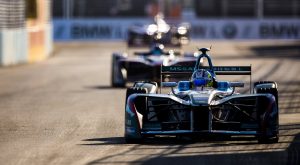
First, it is blood sport and passionate point of engagement for enthusiasts, who hang on every turn and wheel-to-wheel contact.
Second, it’s a test bed for technology, where new tech development can be accelerated under the harshest of conditions, sometimes shortening the process of getting to market.
Finally, racing has always been about marketing—win on Sunday, sell on Monday. There may not be definitive proof of the premise, but there are enough true believers to keep a plethora of race programs prospering.
Electric car racing fits perfectly into this paradigm and it hit Brooklyn, N.Y., this weekend to make its point. The Formula E race series staged the penultimate race of its 12-race series on the Red Hook riverside of Brooklyn and here’s how it touched those three points.
For Enthusiasts
For enthusiasts, the racing was tight and fast—at least relatively. While the winning racers averaged only a shade more than 60 miles an hour, the 10-turn, 1.21-mile course was not designed for pedal-to-the-metal runs. That tight course down in the Brooklyn Cruise Terminal kept the racers bunched but eventual winner Sam Bird from DS Virgin Racing led most of the way and finished 11 seconds ahead of the pack at the end. There were lead changes and wheel-to-wheel and wheel-to-wall contact, the stuff that gets and motorsports enthusiasts’ blood coursing. Mechanical problems kept some cars back and caused some teams to switch strategies between drivers.
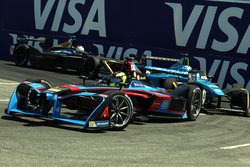
Like its parent racing program, Formula 1, Formula E is strongly international. The top finishers in this race heralded from England, Sweden, Germany, France and Brazil. Race team-owners came from England, India, France and Germany while other competitors came from the U.S., France and China.
For Technology
Formula E is technology-focused even more than the high-tech Formula 1 with its wind-tunnel crafted wings and worldwide telematics connections where race data is bounced through satellites to waiting technicians in control rooms a continent away.
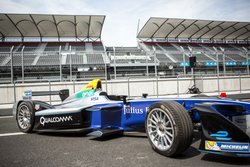
The New York race featured not only two races with drivers, but parallel Roboraces that had driverless cars zipping around the track like slot-cars on steroids. The Roborace cars, due to their more streamlined and lighter stance, were capable of higher speeds than the piloted cars. Straight out of Silicon Valley, Nvidia’s new super chips are at the heart of the driverless cars’ systems.
Other tech companies deeply involved in the race series include Qualcomm and Hewlett-Packard. Enel, an Italian electricity and gas manufacturer and distributor, is the series’ energy partner. The company committed to offset all emissions related to the Brooklyn race’s staging and power through use of its clean energy generation, storage and management solutions. As one example, it created a microgrid at the track to handle the power needs during the race.
Ten teams and 20 drivers competed in this year’s (the third year) Formula E series, which was staged in cities on five continents. The series had fairly strict limitations on its electric motors and batteries, but the organizers promised to open it up to more competition next year, which will put it right in the cross-hairs of the growing electric vehicle field.
For Marketing
Key automakers and suppliers are already pre-positioned, seeing the race series as a way of making sure the public views them as electric car leaders. Audi, BMW, Jaguar and Renault all have significant involvement in the race with teams.
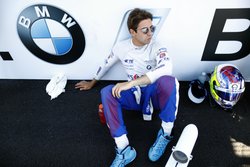
Other companies have joined in for various reasons:
- Virgin Racing, since electric cars seem to be another of Richard Branson’s many interests,
- Mahindra Racing, since the world’s number one tractor company wants to be positioned for a coming electric car push in India,
- Renault, since the company is already one of the leaders in the European electric car race and, as part of the Renault-Nissan Alliance, one of the world leaders in the field,
- Audi Sport, showing VW’s intent of pursuing electric vehicle technology through a familiar venue—racing. and
- Faraday Future, the star-crossed Chinese-funded American electric car startup.
There are more, but the auto companies are also joined by mainstream ones looking for customers drawn to racing or electric cars or the spectacle of international competition. Visa and Qatar Airways had invasive signage throughout the race area and Julius Bär Swiss Private Banking, Tag Heuer and DHL also present.
Tickets for the race did sell out, according to organizers, and the atmosphere appeared to be a cross between a traditional Formula 1 race and a Brooklyn geek street event, with drone races closing the day.
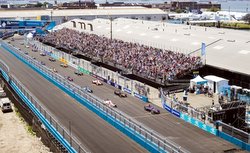
After Brooklyn
Formula E has pledged to return for a fourth season with 14 rounds in 11 cities (two yet to be announced). It will open in Hong Kong and once again conclude in Montreal, adding new venues of Santiago, Chile; Sao Paulo, Brazil and Rome. The series kicks off in December.
This video from Enel gives a good summary of the where companies see this race series going.
And here’s a video of the Roborace cars.
Related Stories You Might Enjoy:
Green Motorsports: Technology Driven Excitement
Green Motorsports: First EV Finisher for Dakar Rally
News: Toyota Sponsors a Race about Efficiency, Not Speed

3 thoughts on “Green Motorsports: Formula E—Electric Cars Race in Brooklyn”